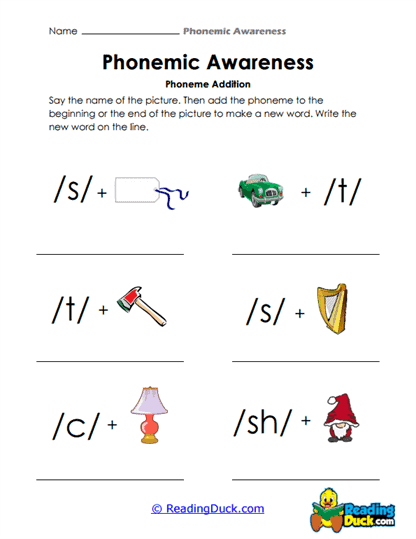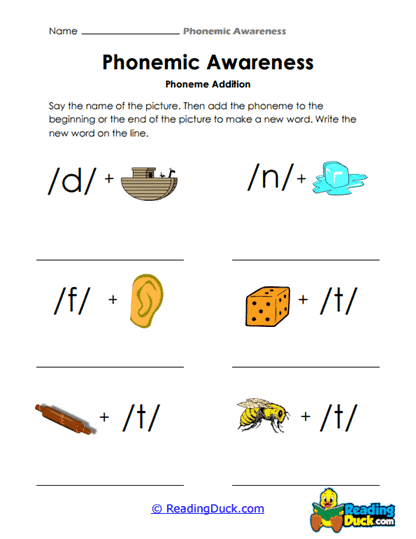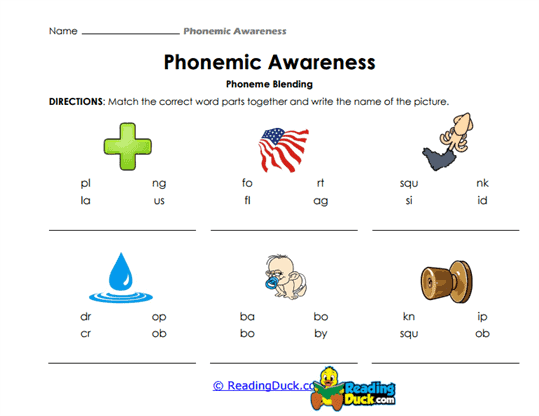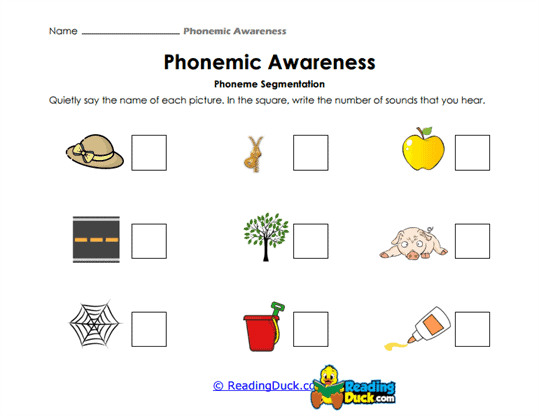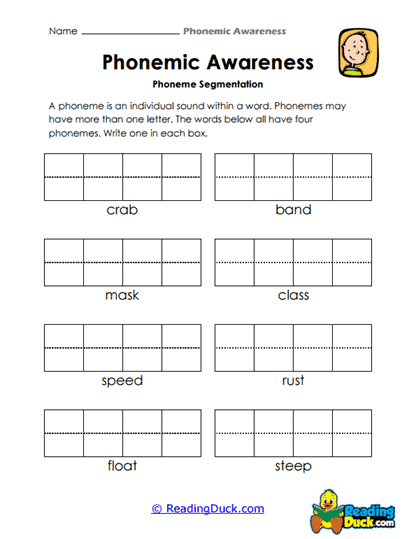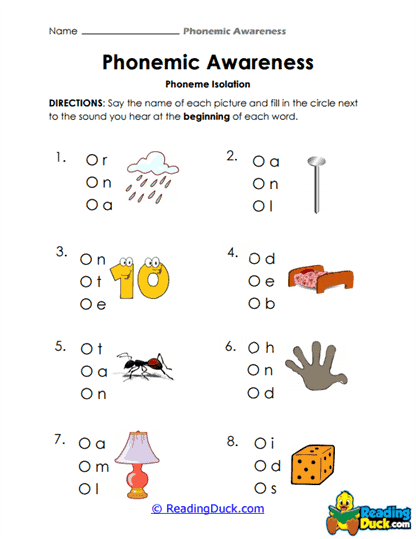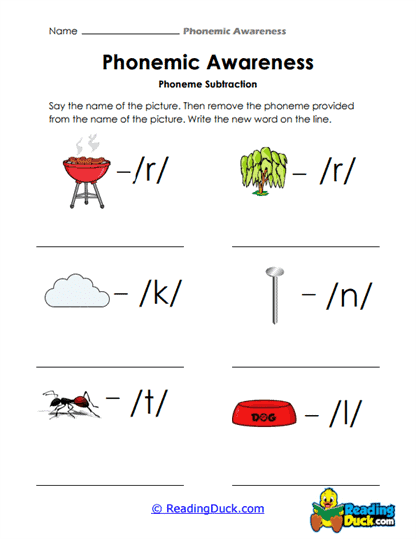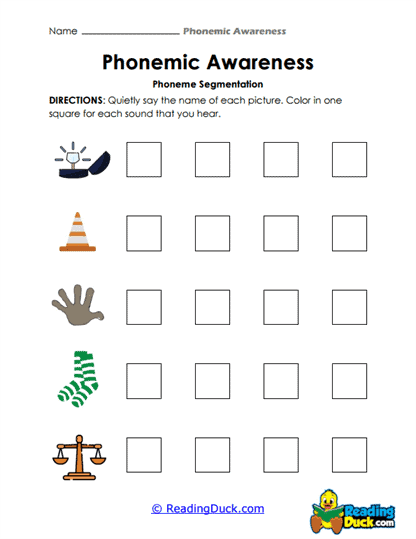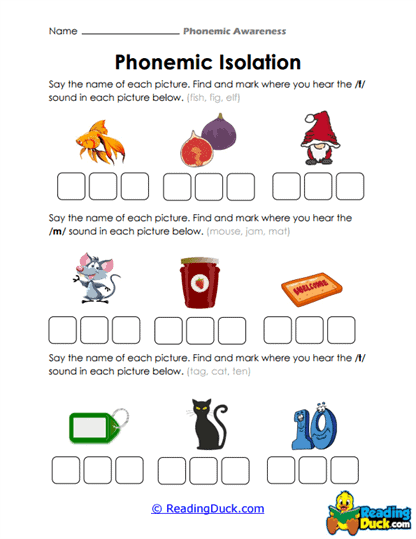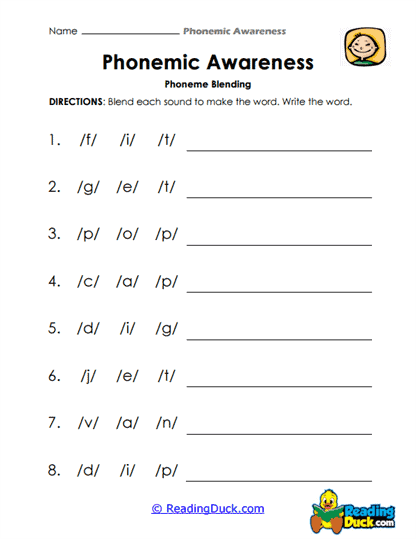Phonemic Awareness Worksheets
About Our Phonemic Awareness Worksheets
Our phonemic-awareness worksheets are structured practice pages that isolate the sound level of language. Using picture cues, Elkonin (sound) boxes, chips, circles, and other simple graphics, each activity asks children to count, segment, blend, delete, or substitute the individual phonemes in a spoken word. Because nothing on the page is meant to be "read," learners concentrate solely on what they hear-dissecting cat into 3-sounds, swapping (m) for (k) to create mat, or coloring one circle per sound. These concrete tasks make the invisible structure of speech visible and measurable.
Repeated, explicit practice with worksheets tunes students’ ears to the grain-size of phonemes and builds the neural pathways they will later recruit for phonics. When learners can already segment and blend sounds automatically, mapping letters to those sounds becomes far easier, leading to quicker decoding and more accurate spelling. The worksheets also generate quick, observable data for teachers, revealing which specific phoneme skills still need attention. In short, by translating an abstract auditory skill into hands-on exercises, phonemic-awareness worksheets lay a critical foundation for fluent, confident reading and writing.
A Look At The Worksheets
First up, we have the "Beginning Sounds" worksheets that help young learners identify the initial sounds in words, laying the groundwork for reading. Next, the "Middle Sounds" worksheets focus on the vowel sounds in the middle of words, crucial for decoding and spelling. The "Counting Phonemes" worksheets challenge students to count the number of sounds in words, enhancing their phonemic awareness. Lastly, the "Elkonin Boxes" worksheets provide a visual method for segmenting words into individual sounds, reinforcing the connection between sounds and letters.
For those ready to level up, the "Phoneme Blending" worksheets guide students in combining individual sounds to form words, a key skill in reading fluency. The "Phoneme Substitution" worksheets offer practice in replacing one sound in a word with another, helping children understand how altering sounds can change word meanings. The "Minimal Pairs" worksheets help learners distinguish between words that differ by only one sound, sharpening their auditory discrimination. Finally, the "Add and Subtract Phonemes" worksheets teach students how adding or removing sounds can create new words, enhancing their phonemic manipulation skills.
So, if your little learner is struggling to tell the difference between a "cat" and a "cap," or thinks "ship" and "chip" are just boat snacks, Reading Duck's got you covered. These worksheets are like brain gym for your ears-except way less sweaty and a lot more adorable. Each activity helps kids untangle the magical, mysterious web of sounds that make up our language, one phoneme at a time. It's like giving your brain a high-five every time you blend, count, or swap a sound. Sound good?
In short, whether your student is a future spelling bee champion or just trying to figure out why "knight" sounds like "night" but looks like it moonlights as a medieval warrior, these phonemic awareness worksheets are here to save the day. Or at least, save you from repeating "What sound does m make?" 47 times in a row. So sharpen those pencils (or crayons, we don't judge), quack open a fresh worksheet, and let Reading Duck help your kids waddle their way to reading success-with a few giggles along the way.
What is Phonemic Awareness?
Phonemic awareness is the ability to notice, isolate, and manipulate the individual speech sounds (phonemes) that make up words. When a child can tell that cat has the three sounds, or can swap (k) for (m) to make mat, they are demonstrating this purely auditory skill. Large-scale evidence synthesized by the U.S. National Reading Panel showed that instruction which teaches children to work consciously with phonemes "significantly improves their reading more than instruction that lacks any attention to phonemic awareness," and that these gains hold across grade levels, ability groups, and socio-economic backgrounds.
Because English print is an alphabet, readers must map written letters (graphemes) onto the phonemes they already hear in speech. Children who can quickly segment sounds in ship find it far easier to connect those three sounds to the letter-string s-h-i-p. Longitudinal work by Bradley & Bryant demonstrated a causal chain here: four- and five-year-olds given daily sound-categorization games out-performed a control group on later reading and spelling, an advantage that persisted well after formal phonics began.
Once decoding starts, phonemic awareness continues to matter because it speeds word recognition. Keith Stanovich's seminal "Matthew Effects" research showed that phonological (including phonemic) awareness is "the most potent single predictor of reading acquisition"; children strong in this skill read more, which in turn accelerates vocabulary growth and comprehension, widening the achievement gap over time.
Phonemic awareness works in reverse when children write: they segment a spoken word into phonemes and choose letters for each one. Studies summarized by the National Reading Panel note that explicit phonemic-awareness training boosts conventional spelling accuracy because students better map phonemes to graphemes. As their decoding and encoding become automatic, cognitive load is freed for noticing morphemes, roots, and word families, accelerating vocabulary learning.
Finally, being able to "crack the code" of print nurtures curiosity and independence. Children who can play with sounds-adding, deleting, or substituting them-approach unfamiliar words as solvable puzzles rather than roadblocks. Researchers note that this sense of agency predicts sustained engagement with books, which in turn reinforces every other academic domain. Without early mastery of phonemic awareness, many learners remain hesitant readers, a stance that can echo throughout their schooling. But with systematic, research-based practice, they gain the auditory foundation that supports fluent, motivated, and lifelong reading.
